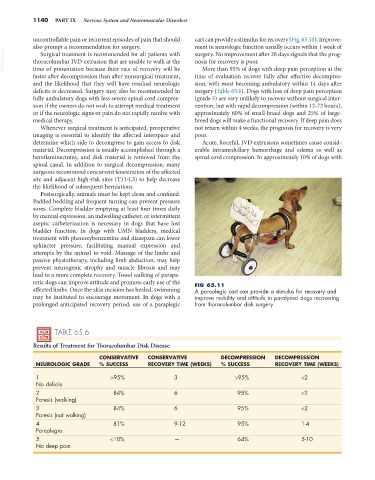Page 1168 - Small Animal Internal Medicine, 6th Edition
P. 1168
1140 PART IX Nervous System and Neuromuscular Disorders
uncontrollable pain or recurrent episodes of pain that should cart can provide a stimulus for recovery (Fig. 65.11). Improve-
also prompt a recommendation for surgery. ment in neurologic function usually occurs within 1 week of
VetBooks.ir thoracolumbar IVD extrusion that are unable to walk at the surgery. No improvement after 28 days signals that the prog-
Surgical treatment is recommended for all patients with
nosis for recovery is poor.
More than 95% of dogs with deep pain perception at the
time of presentation because their rate of recovery will be
faster after decompression than after nonsurgical treatment, time of evaluation recover fully after effective decompres-
and the likelihood that they will have residual neurologic sion, with most becoming ambulatory within 14 days after
deficits is decreased. Surgery may also be recommended in surgery (Table 65.6). Dogs with loss of deep pain perception
fully ambulatory dogs with less severe spinal cord compres- (grade 5) are very unlikely to recover without surgical inter-
sion if the owners do not wish to attempt medical treatment vention, but with rapid decompression (within 12-72 hours),
or if the neurologic signs or pain do not rapidly resolve with approximately 60% of small-breed dogs and 25% of large-
medical therapy. breed dogs will make a functional recovery. If deep pain does
Whenever surgical treatment is anticipated, preoperative not return within 4 weeks, the prognosis for recovery is very
imaging is essential to identify the affected interspace and poor.
determine which side to decompress to gain access to disk Acute, forceful, IVD extrusions sometimes cause consid-
material. Decompression is usually accomplished through a erable intramedullary hemorrhage and edema as well as
hemilaminectomy, and disk material is removed from the spinal cord compression. In approximately 10% of dogs with
spinal canal. In addition to surgical decompression, many
surgeons recommend concurrent fenestration of the affected
site and adjacent high-risk sites (T11-L3) to help decrease
the likelihood of subsequent herniations.
Postsurgically, animals must be kept clean and confined.
Padded bedding and frequent turning can prevent pressure
sores. Complete bladder emptying at least four times daily
by manual expression, an indwelling catheter, or intermittent
aseptic catheterization is necessary in dogs that have lost
bladder function. In dogs with UMN bladders, medical
treatment with phenoxybenzamine and diazepam can lower
sphincter pressure, facilitating manual expression and
attempts by the animal to void. Massage of the limbs and
passive physiotherapy, including limb abduction, may help
prevent neurogenic atrophy and muscle fibrosis and may
lead to a more complete recovery. Towel walking of parapa-
retic dogs can improve attitude and promote early use of the FIG 65.11
affected limbs. Once the skin incision has healed, swimming A paraplegic cart can provide a stimulus for recovery and
may be instituted to encourage movement. In dogs with a improve mobility and attitude in paralyzed dogs recovering
prolonged anticipated recovery period, use of a paraplegic from thoracolumbar disk surgery.
TABLE 65.6
Results of Treatment for Thoracolumbar Disk Disease
CONSERVATIVE CONSERVATIVE DECOMPRESSION DECOMPRESSION
NEUROLOGIC GRADE % SUCCESS RECOVERY TIME (WEEKS) % SUCCESS RECOVERY TIME (WEEKS)
1 >95% 3 >95% <2
No deficits
2 84% 6 95% <2
Paresis (walking)
3 84% 6 95% <2
Paresis (not walking)
4 81% 9-12 95% 1-4
Paraplegia
5 <10% — 64% 5-10
No deep pain

